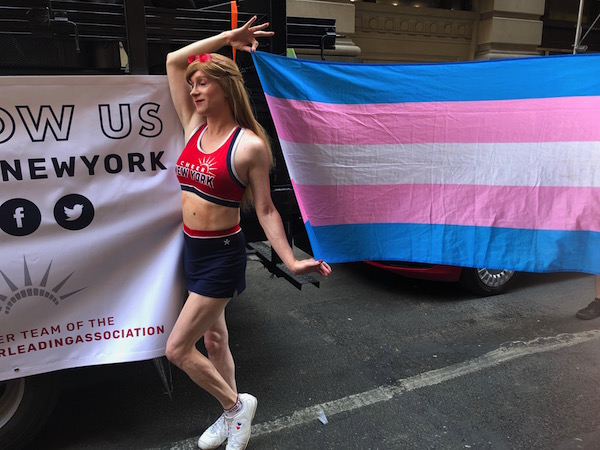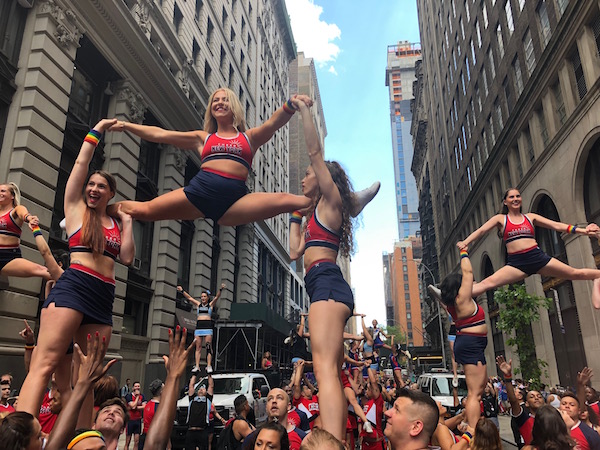
BY CHARLES BATTERSBY | At the stroke of noon on Sunday, June 2, Lady Gaga’s “Born This Way” boomed out on the corner of 37th Ave. and 89th St. in Queens. It was a sound check for Queens Pride. New York City was just 36 hours into Pride Month, and the first of our Pride marches was under way. My group, a 90-member LGBT cheerleading team, Cheer New York, was warming up in the street, eagerly waiting our turn to march. This was our first parade of the year but, within a week, we had also marched in the Brooklyn Pride parade, and some of us had traveled to Philadelphia for Philly Pride, to march with a sister team of LGBT cheerleaders. Ultimately, we would lead a 200-member coalition of cheerleaders from 10 cities, for June 30’s NYC Pride March.
As New York celebrated WorldPride and the 50th anniversary of Stonewall, other cities around the country were holding their own Pride parades, and local LGBT cheerleading teams were marching, even as we walked down Fifth Ave. Many of these teams are part of the Pride Cheerleading Association (PCA)—adult cheerleaders whose membership is comprised of LGBT people and our allies. Each team is a nonprofit organization that raises funds for LGBT causes.
And, of course, we also cheer.
In the four weeks between Queens Pride and Manhattan’s Pride March, Cheer New York performed at half a dozen charitable events. We cheered for two different organizations that help developmentally challenged children, an HIV testing day, the New York chapter of the Anti-Violence Project, and a fundraising drag show—and, when the Pride parades came around, it was time to hear the crowd cheer for us as we marched.
A few days before the NYC Pride March, Chelsea Community News spoke with Colyn Fiendel-Milani, the Athletic Director of Cheer New York, and Wilson Villafaña, the group’s PCA Representative. Both have been on the team for 10 years. Fiendel-Milani recalled how the Pride March has grown in the last decade, “Both as a physical length of space that we march, as well as the amount of people that come to march in the march and in the amount of spectators there.”
Villafaña added, “The number of corporate sponsors and charities that find groups to sponsor has grown a lot in those years.” Both cheerleaders then cited how Cheer New York donates their proceeds to a beneficiary each year.
Such tight association with nonprofit organizations and corporations has caused a rift in the LGBT community. As the Heritage of Pride march was happening, the Reclaim Pride Coalition’s Queer Liberation March was heading through the city, marching without corporate sponsors or floats.
“It’s a very complicated day between Heritage of Pride and Reclaim Pride,” said Fiendel-Milani, who emphasized that he was speaking for himself at this point, not on behalf of Cheer New York, “On the one hand, there are so many people that fought 50 years ago for equality, for their own rights, for safety, to be treated the same as other people. Whether you like it or not, in this day and age, 50 years later, being treated like regular people is also being part of a corporate system. On one hand, we’ve been fighting for things just like this, but now, on the other, some people definitely are striving to maintain their individuality and their equality, which is a complicated line to be at.”
Villafaña also told us, “Everyone should be able to be who they are, and express that in their own special way. If you want to have a march, it’s one of our rights to do so.”
Fiendel-Milani emphasized that the Heritage of Pride march still has an element of “They never want it to be called a parade,” he told us. “They always want it to be called a ‘march.’ It’s still a march. It’s not just a parade. It’s not just about floats. It’s a march showing our individuality and how far we’ve come, but also how far there is to go.”
“I always get choked up when we make that left turn onto Fifth Avenue,” said Villafaña. “As my time in Cheer New York has grown, I’ve understood the symbolism of being able to walk down Fifth Avenue in my uniform. Loud and proud. It took a lot of work for me to get there, but a lot people before me did the work too.”

With New York being the host city for WorldPride, people from around the country wanted to be a part of our march. Last year, a small contingent from Cheer DC joined us, but this year 100 cheerleaders from other teams in the PCA were here. Cheer New York itself has swelled to nearly 100 members of our own (alumni returned to the team just for this occasion). On the day of Manhattan’s march, we needed half a city block to practice our stunts.
The teams arrived at noon, warmed up, and were ready to go. Then we waited.
This march was the biggest ever—and the longest, in terms of how much time it took for all of the groups to traverse the route. We used new routes along wider streets, in anticipation of the massive crowds that turned out this year.
This year, the weight of WorldPride was in full force. Our staging area was on 31st St., eight blocks north of the official starting area at Madison Square Park. Other groups were amassed even further up Fifth Ave. The Pride Cheerleading Association watched for hour after hour, as floats rolled past our block. The delays gave us ample time to socialize with cheerleaders from other cities, and snap pictures doing stunts.
As the afternoon passed, our spirit began to wane. Groups of cheerleaders sat on the curb, or in the middle of the street, a few napped with their heads in their friends’ laps. Coaches reminded us to stay warm and do stretches, as rain showers came and went twice. After a four-hour wait, it was time to go!
It took nearly an hour to march from our staging area to the starting point. Even though we hadn’t even officially begun, there was a crowd gathered on both sides of the street, and in Madison Square Park. Our 200 members were organized. Clever mnemonic devices helped us memorize the precise order of which stunt or dance came next. Our months of practice made us secure in forming pyramids on asphalt.
The coaches gave silent signals, like military commanders on a battlefield, and soldiers passed the orders down the line, which stretched a city block. At the right moment, 200 cheerleaders deployed into five-person “stunt pods,” throwing each other in the air. Those who weren’t doing stunts rushed to the front and launched into synchronized dance choreography. Before we had even reached the official starting point, we had time to practice nearly all of our moves for a live crowd.
The sidewalks swelled once we got south of 23rd St., to the parade route proper. Stores had redecorated their windows and facades for the occasion. Selfie spots and rainbows were everywhere. The crowd was noticeably larger than last year. People had even climbed up on construction scaffolding to secure a good view.
We turned west on Eighth St., heading towards Christopher St., Sheridan Square, and the Stonewall Inn. The streets were narrower in this part of the march, chosen for historical significance, rather than for accessibility.

The Brooklyn Pride march has a narrow section like this too, so we were prepared for it. Our formation tightened up, even as people leaned out over the barricades looking for high fives, hugs, or the chance to grab a cheerleader for a selfie.
The occasional police officer ran by with a dog, sniffing bags for guns and bombs. The narrow streets, and awkward intersection at Sixth Ave., made me think that a clever terrorist might pick this exact spot for a shooting gallery.
As I was thinking of snipers, a middle-aged couple waved at me and screamed, “Come here!” I ran over, expecting a handshake, or a high-five, but, before I knew it, I was being hugged by strangers who told me they love me. Despite fears of terrorist attacks, the biggest surprise was an unexpected hug from stand-in parents.
A block later, we arrived at the Stonewall. It’s past 6pm at this point. We only had a few seconds in front of the Stonewall, and this was our chance to do our special “Flag” pyramid. It takes 16 people, four groups of four, each hoisting a tiny cheerleader called a “flyer” above our heads. At the top, one flyer unfurls a flag, and the other three each grab a corner.
My stunt pod lifted our flyer. I counted to eight, while 47 other cheerleaders around me kept the same count. I glanced up to see a rainbow flag unfurling. I had two more eight-counts before it was time to gently lower the flyer to the ground.
Behind me, another 16 cheerleaders held a second rainbow flag. To my right, 16 more raised the pink, blue, and white of the transgender pride flag. As I counted, I had enough time to look out at the crowd, and see new flags. Pink, blue, and purple for bisexual. Gray stripes for asexuals. New rainbows, adding black and brown for race.
We brought the flyer down on “Five” in the next eight-count, just enough time to do the math: At 16 people per flag, our team now has enough members to add a few more flags to this routine next year.
More about Cheer New York can be found at www.cheernewyork.org.
Chelsea Community News is made possible with the help of our awesome advertisers, and the support of our readers. If you like what you see, please consider taking part in our GoFundMe campaign (click here). To make a direct donation and/or send feedback about the site, send an email to Scott@chelseacommunitynews.com.

Pingback: Otter Creek Polonium For Sale
Pingback: Buy BRNO COMPETITION SKEET Online
Pingback: บาคาร่าเกาหลี
Pingback: Ozempic zu verkaufen
Pingback: รับทำเว็บไซต์
Pingback: hanongnong
Pingback: Lsm99bet เว็บหวยสด 24 ชั่วโมง
Pingback: บุหรี่นอกราคาถูก
Pingback: instant crypto exchange
Pingback: blote tieten
Pingback: รับเช่าพระ
Pingback: รับออกแบบกราฟิก
Pingback: torqeedo electric motor|achiles boat|achillies inflatable boat|yamaha vmax 2021|avon boats|achilies boats|achillies inflatable boats|200 hp merc outboard|avon inflatable boats|avon boat|avon inflatable boat|honda boats|200hp mercury outboard|achillies inf
Pingback: เกมไพ่
Pingback: Native Smokes
Pingback: แจกเครดิตฟรี
Pingback: click to read
Pingback: article
Pingback: visit
Pingback: sbobet
Pingback: Bulgarian makarov
Pingback: Swiss Remedies PRIMOBOLAN
Pingback: matrimoniale
Pingback: บอลโลกโซนยุโรป
Pingback: https://languageskillsabroad.com/how-to-write-an-article-for-website-publication/
Pingback: DevOps Service Providers
Pingback: Automation Test tool
Pingback: https://wifina.be/regroupement-credit/
Pingback: สโบเบ็ต
Pingback: 스카이툰
Pingback: Power to Choose
Pingback: blogtov
Pingback: vice city market link
Pingback: dark0de
Pingback: ถาดกระดาษ
Pingback: cvv bins